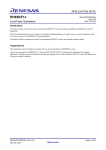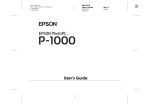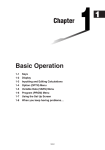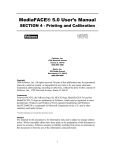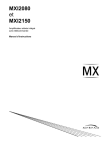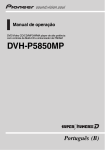Download AC International UPP Network Card User Manual
Transcript
Pocket Programmer UPB Pocket Programmer User Guide Model UPP Pocket Programmer DESCRIPTION The Pocket Programmer (model UPP) provides many of the features of UPStart UPB configuration software in a portable hand held device. The Pocket Programmer comes with a handy carrying case and AC power cord that plugs into any standard receptacle allowing communication to installed UPB devices. The Pocket Programmer is intended for use by an installer who is familiar with UPStart and UPB products. It virtually eliminates the need to have a PC with UPStart software and a Computer Interface Module (CIM) at every jobsite. It makes configuring UPB devices from room to room, quick and easy. The UPP may be used instead of UPStart to provide initial configuration steps such as adding devices to a UPB network or disabling dimming allowing a newly installed switch to operate a fluorescent fixture. It could also be used to program an entire UPB installation. No data is stored in the UPP. The UPB network and device programming is stored in each UPB device. A UPB network that was configured with the UPP may be added to UPStart at any time by using the Network Discovery feature in UPStart. The UPP has diagnostic tools that include a noise and signal meter and an explorer feature that reads and transmits UPB messages on the powerline. In the Run CIM mode the Pocket Programmer may be used as a Computer Interface Module. Model UPP IMPORTANT SAFETY INSTRUCTIONS When using electrical products, basic safety precautions should always be followed, including the following: 1. READ AND FOLLOW ALL SAFETY INSTRUCTIONS. 2. Keep away from water. If product comes into contact with water or other liquid, unplug immediately. 3. Never use products that have been dropped or damaged. 4. Do not use this product outdoors. 5. Do not use this product for other than its intended use. 6. To avoid risk of fire, burns, personal injury and electric shock, install this product out of reach of small children. 7. Do not cover the product with cloth, paper or any material when in use. 8. This product uses polarized plugs and sockets (one blade is wider than the other) as a feature to reduce the risk of electric shock. These plugs and sockets fit only one way. If they do not fit, contact a qualified technician. Do not use with an extension cord unless plugs can be fully inserted. Do not alter or replace plugs. 9. SAVE THESE INSTRUCTIONS. -2- Pocket Programmer Model UPP INSTALLATION The Pocket Programmer is designed for indoor use. Simply plug the appropriate end of the provided AC cord into the top of the UPP, the other end into any 120-volt outlet anywhere in the house. Once the Pocket Programmer completes its start up procedure the top two (of six) selections of the main menu are on the display and it is ready for use. UP MENU LEFT ENTER RIGHT DOWN BUTTONS: The buttons provide easy navigation through the Pocket Programmer’s menus on the LCD display. MENU: Returns the display to the previous menu from any sub-menu, exits selection without writing to selected device. FUNCTION The Pocket Programmer has an LCD display with 2 lines of 16 characters, a diagnostic LED, 7 buttons, a polarized power connector and a DB-9 port. UP and DOWN: Provide movement through the menus and toggle through characters when editing a selection. RIGHT and LEFT: Provide movement across the display. ENTER: Enters a selected menu item. Provides movement through selected menu item editable fields, and executes commands and edits that are sent to the selected device or network. 3 Pocket Programmer FUNCTION: Toggles the backlight on the LCD display. LED: The diagnostic LED operates just as the LED on the Computer Interface Module. In Run CIM mode the Pocket Programmer exchanges UPB messages between the powerline and the connected computer or controller. The indicator on the UPP will glow AMBER when powered, flash RED when UPB messages are seen on the power line and flash GREEN when a UPB message is transmitted from the Pocket Programmer. DB9 Port: Connect a standard serial cable to an RS-232 port to use the Pocket Programmer as a Computer Interface Module. The DB9 port may also be used to upgrade the firmware in the UPP. MENU NAVIGATION Pressing the <MENU> button backs out of a selection without making changes. Pressing <ENTER> opens the menu selection and submenus. Some menus require the use of the <UP>/<DOWN> and <RIGHT>/<LEFT> buttons to edit characters and move the cursor position. Model UPP USING THE POCKET PROGRAMMER The pocket programmer mirrors the functionality of UPStart Configuration software. If the installer is familiar with UPStart then most of the UPP menus and functions are intuitive and easy to use. If there are any questions or difficulties in using the UPP referencing the specific function in the UPStart software is highly recommended. The pocket programmer identifies device by Device ID number, device names are not used. It is highly recommended that the User knows (has created a list or plan for) the device’s ID when programming. A device’s ID can ‘Viewed’ by putting the device in setup mode then use the pocket programmer to View the device from the Access Network sub-menu. UPDATING THE POCKET PROGRAMMER The Pocket Programmer was designed with the future in mind. As new UPB devices become available the UPP will need to have its program updated to allow use with these new devices. To update your UPP, please visit www.Simply-Automated.com/UPPUPDATE and follow the instructions. A personal computer with a connection for a DB9 serial cable is required. 4 Pocket Programmer Model UPP Access Network is used on an installed UPB network. It is useful when viewing or editing devices. Devices can be added or deleted. Links may also be added or deleted. The same functions are available in UPStart under the Device, Link and Network menus. 5 Pocket Programmer New Network Model UPP 1)Access Network 1 2)New Network <DOWN> <MENU> 1)Access Network 2 2)New Network <ENTER> New Network is used to create a UPB network by starting with a Network ID and Password. The Network ID can be from 1 – 250. It is recommended to use a different Network ID for each installation. The password is 4 hexidecimal characters, 0 – 9 and A – F. Once the UPB network is created devices and Links may be added. Nothing is stored in the UPP. All data is stored in the devices as they are added. UPB device must share the same UPB Network ID and password to communicate peer to peer. <MENU> Select Net ID=001 <UP> Select Net ID=002 <UP> To desired Network ID <ENTER> Select Net ID=001 <Search for Net> <MENU> Select Net ID=001 Select Pswd=0000 <UP> Select Net ID=001 Select Pswd=1000 <RIGHT> Select Net ID=001 Select Pswd=1000 Continue until desired Password <ENTER> <MENU> 1)Add Device 1 2)Edit Device <ENTER> to Add Device (See Add Device page) <DOWN> to scroll through this sub-menu (See Access Network Sub-Menu) 6 Pocket Programmer Model UPP Add Device is used to add installed UPB devices to the UPB network. If a device is not found: 1. Make sure there is only one device in set up mode. 2. Check the wiring to ensure the connections are proper and the wire nuts are on tight. 3. Check the phase coupler to ensure it is properly installed and operational. 7 Pocket Programmer Model UPP Edit Device is used to change the settings on a previously added device. For instance, the dimming can be disabled under the Options sub-menu. -8- Pocket Programmer Model UPP 9 Pocket Programmer Model UPP 10 Pocket Programmer Model UPP Edit Device Sub-Menu – Transmit Links 1)ID 1 2)Receive Links <UP/DOWN> 1)ID 2 2)Receive Links <ENTER> <Reading Device> <UP/DOWN> 2)Receive Links 3)Transmit Links 3 01)Link=241 <MENU> 0 Super Toggler <UP/DOWN> Super Toggler <UP/DOWN> ... 08)Link=--Super Toggler <ENTER> 3)Transmit Links 4)Options 4 <MENU> 01)Link=241 Super Toggler <UP/DOWN> 01)Link=242 Super Toggler Field rolls over. Range is 001 to 250 <UP/DOWN> 01)Link=241 On/Off Button Choices as Down Button is pressed: Super Toggler Link Actuator Toggle Button Drape Close Super Multi-Button Drape Open Multi-Button Null Button Panic Button BtmSuperRocker Bottom Rocker TopSuperRocker Top Rocker Indicator Off Dim Button Indicator On Bright Button Status Button On Button On/Off Button Off Button <ENTER> <UP/DOWN> 4)Options 5 5)Advanced 01)Link=241 Super Toggler <MENU> 1)Add Device 1 2)Edit Device <UP/DOWN> 02)Link=--- <ENTER> 01)Link=241 <Writing> 11 Pocket Programmer Model UPP 12 Pocket Programmer Model UPP 1)ID 1 2)Receive Links Edit Device - Advanced <UP/DOWN> 1)ID 2 2)Receive Links <UP/DOWN> 2)Receive Links 3 3)Transmit Links <UP/DOWN> <ENTER> 1)Xmit Type: 1 2)Xmit Atmpts: <ENTER> Transmit Type= 1)Xmit Type: 2 2)Xmit Atmpts: <ENTER> 2)Xmit Atmpts: 3 3)Xmit 2 Rpeatr: <ENTER> Link <UP/DOWN> Transmit Type= Direct <MENU> <ENTER> <Writing> 3)Transmit Links 4 4)Options <UP/DOWN> TX Attempts=2 <UP/DOWN> 1 to 4 <MENU> <ENTER> <Writing> 4)Options 5 5)Advanced <MENU> 1)Add Device 1 2)Edit Device Xmit to Repeatr: No Repeater <UP/DOWN> Xmit to Repeatr: Repeater, Tx=1 <MENU> <ENTER> <Writing> <UP/DOWN> Tx=1 to 3 13 Pocket Programmer 1)Add Device 1 2)Edit Device <ENTER> Model UPP View Device View is Read Only <MENU> View Device is used to check the current settings of a UPB device. Settings can be observed but not changed. 1)Add Device 2 2)Edit Device <ENTER> <MENU> 2)Edit Device 3)View Device 3 <ENTER> Select DevID=001 <MENU> <UP> Select DevID=002 To desired Device ID <UP> <ENTER> Select DevID=001 <SAI UML> ELSE Err: Device Not Found If device is not found <ENTER> <MENU> 1 1)ID 2)Receive Links <UP/DOWN> <ENTER> Go to Edit/View Device Sub-Menu 1)ID 2 2)Receive Links <UP/DOWN> 2)Receive Links 3)Transmit Links 3 <UP/DOWN> 3)Transmit Links 4)Options 4 <UP/DOWN> 4)Options 5 5)Advanced 14 Pocket Programmer Model UPP Add Link 1)Access Network 1 2)New Network <ENTER> Add Link is used to create and add a Link to one or more UPB devices. <MENU> Select Net ID=001 <UP> Select Net ID=002 <UP> To desired Network ID <ENTER> <MENU> Select Net ID=001 Select Pswd=0000 <UP> Select Net ID=001 <RIGHT> Select Net ID=001 Select Pswd=1000 Select Pswd=1000 Continue until desired Password <ENTER> 1)Add Device 1 2)Edit Device <DOWN> 1)Add Device 2 2)Edit Device <MENU> Enter Setup Mode Add Link=001 <DOWN> <UP/DOWN> To Select Device ID 2)Edit Device 3 3)View Device Device that is to have the Link added must be in Setup Mode. This feature will work with multiple devices as long as all are in Setup Mode. <ENTER> <DOWN> <Link Added> Add Link=001 3)View Device 4 4)Delete Device <ENTER> <MENU> or <ENTER> This will display even if no device was put in Setup Mode, hence no Link added. <DOWN> 4)Delete Device 5 5)Add Link 15 Pocket Programmer Model UPP . 16 Pocket Programmer Model UPP UPB Explorer – Smart Transmit 1 1)Access Network 2)New Network <ENTER> <UP/DOWN> 1 1)Smart Transmit 2)Smart Receive <UP/DOWN> 1)Access Network 2)New Network 2 1)Smart Transmit 2)Smart Receive 2 <UP/DOWN> <UP/DOWN> 2)New Network 3 3)UPB Explorer <MENU> 2)Smart Receive 3 3)Expert Receive <UP/DOWN> 3)Expert Receive 4 4)Expert Transmit Smart Transmit is used test communications of Links or control of devices. <ENTER> Select Type=LINK <UP/DOWN> Select Type=DIRCT <ENTER> Select Type=Link Select NetID=001 <UP/DOWN> To select Network ID <UP/DOWN> To select Link ID <ENTER> Link = 001 1)Activate <ENTER> Link = 001 1)Activate <UP/DOWN> Link = 001 2)Deactivate . . . Link = 001 9)Blink <ENTER> Link = 001 <Sent> 1)Activate 2)Deactivate 3)Goto ON 4)Goto OFF 5)Goto <ENTER> 050% 6)Fade UP/STOP 7)Fade DOWN/STOP 8)Fade STOP 9)Blink (Goto <ENTER> allows selection of level with <UP/DOWN> buttons. Fade UP/ STOP and Fade DOWN/STOP brighten or dim while holding the <ENTER> button and stop upon release). 17 Pocket Programmer Model UPP . Smart Receive is used to observe UPB transmissions. 18 Pocket Programmer Model UPP . 19 Pocket Programmer Model UPP Simply Automated, Incorporated 5825 Avenida Encinas, Suite 101, Carlsbad, CA 92008 USA Technical Support: www.simply-automated.com or 800-630-9234 452-0031-0001 Rev. A Revised: May 16, 2006 20























